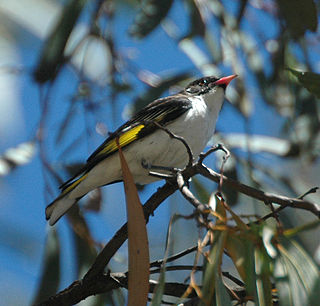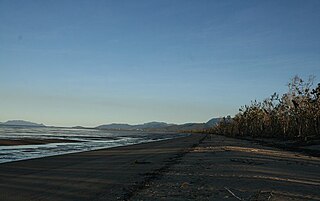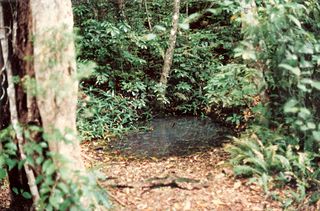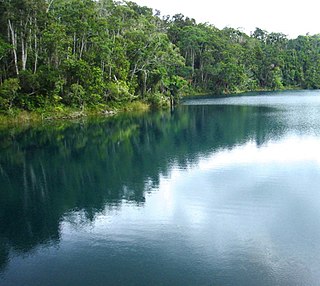| Mouth of Baffle Creek Conservation Parks Queensland | |
|---|---|
IUCN category III (natural monument or feature) | |
| Nearest town or city | Bundaberg |
| Coordinates | 24°30′57″S152°03′24″E / 24.51583°S 152.05667°E Coordinates: 24°30′57″S152°03′24″E / 24.51583°S 152.05667°E |
| Established | 1990 [1] |
| Area | 3.12 hectares (7.7 acres) [1] |
| Managing authorities | Queensland Parks and Wildlife Service |
| Website | Mouth of Baffle Creek Conservation Parks |
| See also | Protected areas of Queensland |
The Mouth of Baffle Creek Conservation Parks are a series of two protected conservation parks located adjacent to the mouth of the Baffle Creek, on the central coastal region of Queensland, Australia.

State parks are parks or other protected areas managed at the sub-national level within those nations which use "state" as a political subdivision. State parks are typically established by a state to preserve a location on account of its natural beauty, historic interest, or recreational potential. There are state parks under the administration of the government of each U.S. state, some of the Mexican states, and in Brazil. The term is also used in the Australian state of Victoria. The equivalent term used in Canada, Argentina, South Africa and Belgium, is provincial park. Similar systems of local government maintained parks exist in other countries, but the terminology varies.
In Australia a conservation park is a type of specially protected status for land held by the Crown for conservation purposes. A conservation park may consist of multiple conservation units. As of June 2014, the term ‘Conservation Park’ is used only by the relevant government agencies in Queensland, South Australia and Western Australia.

Central Queensland is an ambiguous geographical division of Queensland that centres on the eastern coast, around the Tropic of Capricorn. Its major regional centre is Rockhampton. The region extends from the Capricorn Coast west to the Central Highlands at Emerald, north to the Mackay Regional Council southern boundary, and south to Gladstone. The region is also known as Capricornia. It is one of Australia's main coal exporting regions.
Contents
The 312-hectare (770-acre) parks [1] are within the Great Barrier Reef Marine Park coastal region. Baffle Creek is one of Queensland's few remaining undisturbed coastal rivers, and the creek's estuary mouth is protected by Mouth of Baffle Creek Regional Park. This small coastal remnant features sandy beaches backed by low, open, eucalypt and she-oak woodlands with a camping area set behind the fore dunes on the creek's northern shore. There is no camping area on the creek's southern side. [2]
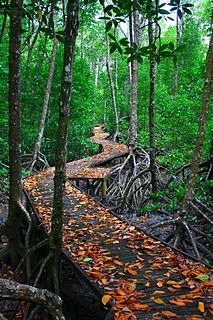
The Great Barrier Reef Marine Park protects a large part of Australia's Great Barrier Reef from damaging activities. It is a vast multiple-use Marine Park which supports a wide range of uses, including commercial marine tourism, fishing, ports and shipping, recreation, scientific research and Indigenous traditional use. Fishing and the removal of artefacts or wildlife is strictly regulated, and commercial shipping traffic must stick to certain specific defined shipping routes that avoid the most sensitive areas of the park. The Great Barrier Reef is the largest and best known coral reef ecosystem in the world. Its reefs, almost 3000 in total, represent about 10 per cent of all the coral reef areas in the world. It supports an amazing variety of biodiversity, providing a home to thousands of coral and other invertebrate species, bony fish, sharks, rays, marine mammals, marine turtles, sea snakes, as well as algae and other marine plants.
The Mouth of Baffle Creek Conservation Park 1 is a 125-hectare (310-acre) park is located on the creek mouth's southern shore and was first gazetted in 1995 to protect an area of mangrove forest. The Mouth of Baffle Creek Conservation Park 2 is a 187-hectare (460-acre) park protects the creek mouth's northern shore and was first gazetted in 1997, with further land protected in 2010. [1]

A mangrove is a shrub or small tree that grows in coastal saline or brackish water. The term is also used for tropical coastal vegetation consisting of such species. Mangroves occur worldwide in the tropics and subtropics, mainly between latitudes 25° N and 25° S. The total mangrove forest area of the world in 2000 was 137,800 square kilometres (53,200 sq mi), spanning 118 countries and territories.





